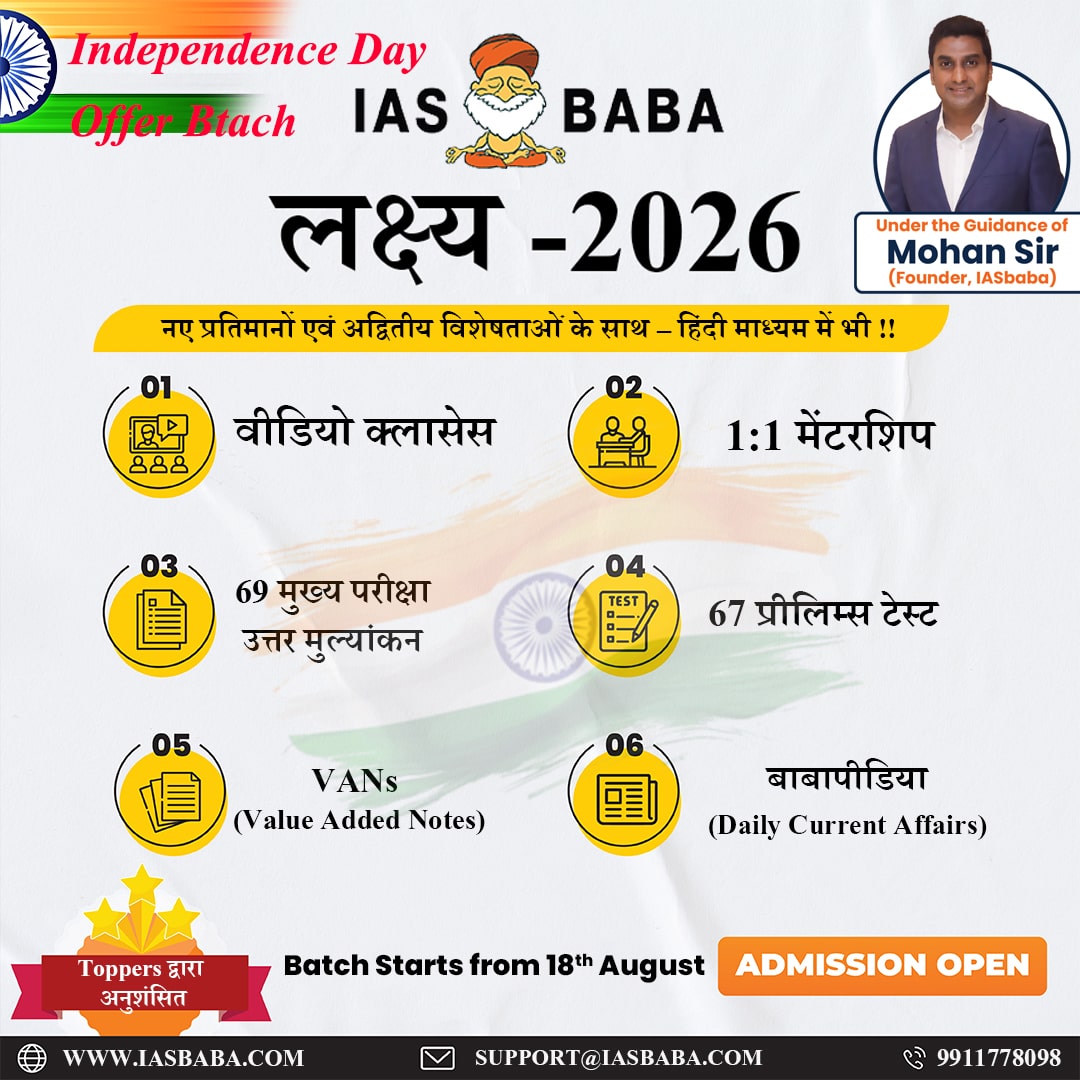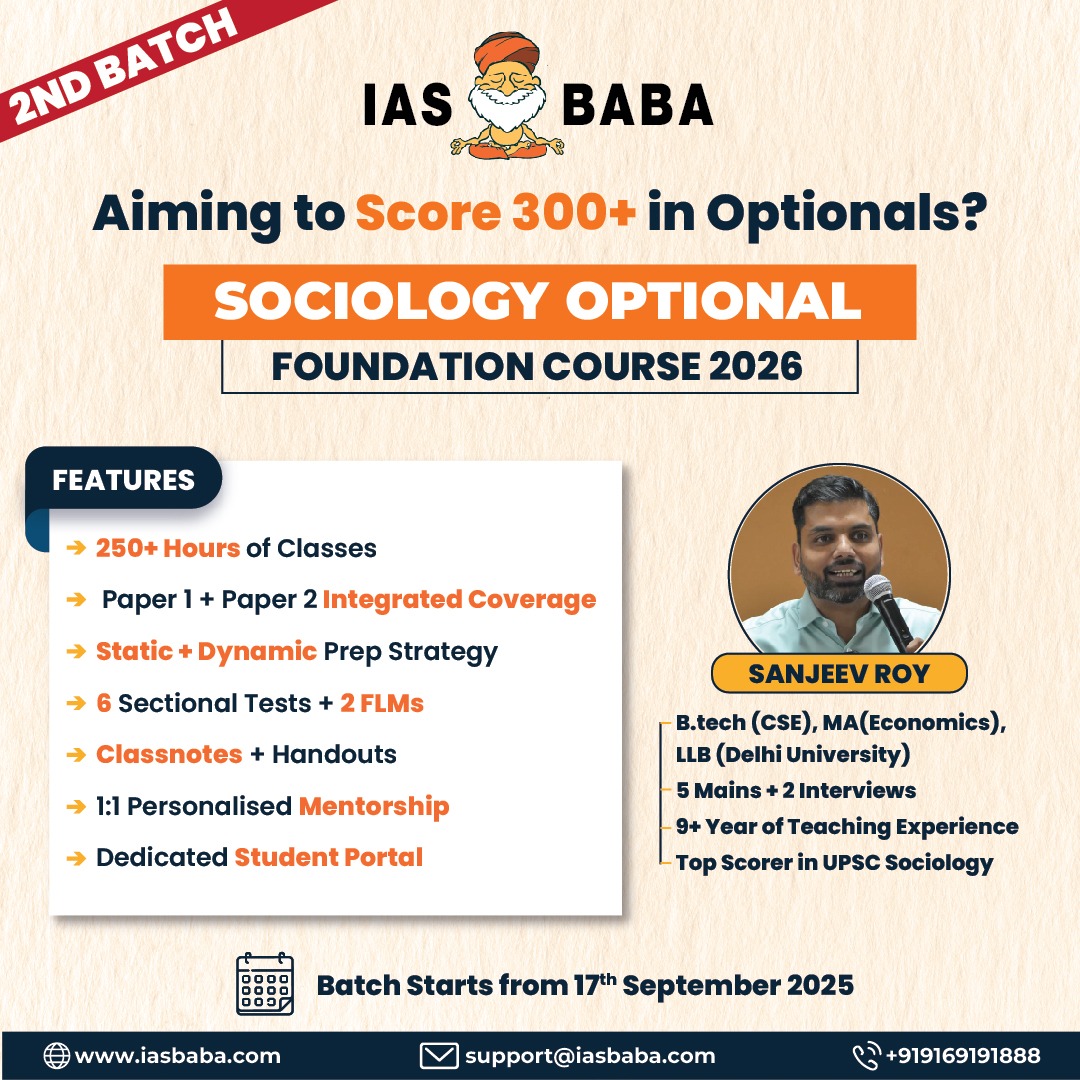IASbaba Daily Prelims Quiz
For Previous Daily Quiz (ARCHIVES) – CLICK HERE
The Current Affairs questions are based on sources like ‘The Hindu’, ‘Indian Express’ and ‘PIB’, which are very important sources for UPSC Prelims Exam. The questions are focused on both the concepts and facts. The topics covered here are generally different from what is being covered under ‘Daily Current Affairs/Daily News Analysis (DNA) and Daily Static Quiz’ to avoid duplication. The questions would be published from Monday to Saturday before 2 PM. One should not spend more than 10 minutes on this initiative.
Gear up and Make the Best Use of this initiative.
Do remember that, “the difference between Ordinary and EXTRA-Ordinary is PRACTICE!!”
Important Note:
- Don’t forget to post your marks in the comment section. Also, let us know if you enjoyed today’s test 🙂
- After completing the 5 questions, click on ‘View Questions’ to check your score, time taken, and solutions.
Test-summary
0 of 5 questions completed
Questions:
- 1
- 2
- 3
- 4
- 5
Information
To view Solutions, follow these instructions:
- Click on – ‘Start Test’ button
- Solve Questions
- Click on ‘Test Summary’ button
- Click on ‘Finish Test’ button
- Now click on ‘View Questions’ button – here you will see solutions and links.
You have already completed the test before. Hence you can not start it again.
Test is loading...
You must sign in or sign up to start the test.
You have to finish following test, to start this test:
Results
0 of 5 questions answered correctly
Your time:
Time has elapsed
You have scored 0 points out of 0 points, (0)
| Average score |
|
| Your score |
|
Categories
- Not categorized 0%
| Pos. | Name | Entered on | Points | Result |
|---|---|---|---|---|
| Table is loading | ||||
| No data available | ||||
- 1
- 2
- 3
- 4
- 5
- Answered
- Review
-
Question 1 of 5
1. Question
Which of the following factors contributed significantly to the achievement of India’s FY25 fiscal deficit target?
- Restrained revenue expenditure
- High disinvestment proceeds
- Robust capital expenditure
- Higher-than-expected non-tax revenue
Select the correct answer using the code below:
Correct
Correct Answer: b) 1, 3 and 4 only
Explanation:
1. Restrained revenue expenditure – This refers to the government keeping a tight control on non-capital, routine expenses such as salaries, subsidies, and interest payments. By restraining these, the government avoids unnecessary fiscal pressure.
2. High disinvestment proceeds – While disinvestment (selling stakes in public sector enterprises) can contribute to non-debt capital receipts, recent fiscal years have seen underperformance in this area, so it was not a major contributor in FY25.
3. Robust capital expenditure – The government increased spending on infrastructure and capital assets, which, though costly, spurs economic growth and can improve long-term fiscal health through increased revenue.
4. Higher-than-expected non-tax revenue – Includes spectrum sale proceeds, dividends from RBI/PSUs, and other non-tax income sources. FY25 saw strong performance in this area, helping bridge fiscal gaps.Incorrect
Correct Answer: b) 1, 3 and 4 only
Explanation:
1. Restrained revenue expenditure – This refers to the government keeping a tight control on non-capital, routine expenses such as salaries, subsidies, and interest payments. By restraining these, the government avoids unnecessary fiscal pressure.
2. High disinvestment proceeds – While disinvestment (selling stakes in public sector enterprises) can contribute to non-debt capital receipts, recent fiscal years have seen underperformance in this area, so it was not a major contributor in FY25.
3. Robust capital expenditure – The government increased spending on infrastructure and capital assets, which, though costly, spurs economic growth and can improve long-term fiscal health through increased revenue.
4. Higher-than-expected non-tax revenue – Includes spectrum sale proceeds, dividends from RBI/PSUs, and other non-tax income sources. FY25 saw strong performance in this area, helping bridge fiscal gaps. -
Question 2 of 5
2. Question
The term Virtual Digital Assets (VDAs) in India includes which of the following?
- Cryptocurrencies
- Non-Fungible Tokens (NFTs)
- Central Bank Digital Currency (CBDC)
- Digital collectibles traded over blockchain
Select the correct answer using the code below:
Correct
Correct Answer: b) 1, 2 and 4 only
Explanation:
1. Cryptocurrencies – These include Bitcoin, Ethereum, and others, and are classified as VDAs under Indian tax law.
2. Non-Fungible Tokens (NFTs) – Unique digital assets on blockchain, also recognized as VDAs.
3. CBDC – The Central Bank Digital Currency (Digital Rupee) is issued and regulated by RBI and explicitly excluded from the definition of VDAs.
4. Digital collectibles – Items such as blockchain-traded game assets or digital artworks fall under the category of VDAs if they meet certain criteria.Incorrect
Correct Answer: b) 1, 2 and 4 only
Explanation:
1. Cryptocurrencies – These include Bitcoin, Ethereum, and others, and are classified as VDAs under Indian tax law.
2. Non-Fungible Tokens (NFTs) – Unique digital assets on blockchain, also recognized as VDAs.
3. CBDC – The Central Bank Digital Currency (Digital Rupee) is issued and regulated by RBI and explicitly excluded from the definition of VDAs.
4. Digital collectibles – Items such as blockchain-traded game assets or digital artworks fall under the category of VDAs if they meet certain criteria. -
Question 3 of 5
3. Question
With reference to the historical background of the Kheer Bhawani temple, consider the following statements:
- It finds mention in Kalhana’s Rajatarangini.
- The deity is believed to have been brought from Sri Lanka by Hanuman according to legend.
- The temple was commissioned by Emperor Ashoka as part of his Buddhist reforms.
Which of the statements given above is/are correct?
Correct
Correct Answer: a) 1 and 2 only
Explanation:
1. Kalhana’s Rajatarangini – A 12th-century historical chronicle of the kings of Kashmir, which references the Kheer Bhawani temple.
2. Legend involving Hanuman – Folklore holds that Hanuman carried the idol from Lanka to Kashmir, symbolizing divine intervention and protection of the goddess.
3. Commissioned by Ashoka – Ashoka’s constructions were Buddhist-oriented. No evidence links him to Kheer Bhawani, a Hindu templeIncorrect
Correct Answer: a) 1 and 2 only
Explanation:
1. Kalhana’s Rajatarangini – A 12th-century historical chronicle of the kings of Kashmir, which references the Kheer Bhawani temple.
2. Legend involving Hanuman – Folklore holds that Hanuman carried the idol from Lanka to Kashmir, symbolizing divine intervention and protection of the goddess.
3. Commissioned by Ashoka – Ashoka’s constructions were Buddhist-oriented. No evidence links him to Kheer Bhawani, a Hindu temple -
Question 4 of 5
4. Question
In the context of India becoming the world’s fourth-largest economy, which of the following best explains the limitations of using nominal GDP as a development indicator?
Correct
Correct Answer: b) It ignores inflation and purchasing power parity.
Explanation:
Nominal GDP reflects total market value of goods and services produced, calculated using current prices.
It does not adjust for inflation, which may inflate or distort growth figures.
It ignores purchasing power parity (PPP), which is crucial to compare standard of living across countries.
Hence, using nominal GDP alone may not give an accurate picture of actual development or living standards.Incorrect
Correct Answer: b) It ignores inflation and purchasing power parity.
Explanation:
Nominal GDP reflects total market value of goods and services produced, calculated using current prices.
It does not adjust for inflation, which may inflate or distort growth figures.
It ignores purchasing power parity (PPP), which is crucial to compare standard of living across countries.
Hence, using nominal GDP alone may not give an accurate picture of actual development or living standards. -
Question 5 of 5
5. Question
Which of the following best explains the term “Heat Action Plans (HAPs)” as mentioned in the context of India’s climate adaptation efforts?
Correct
Answer: C
Explanation:
Heat Action Plans (HAPs) are strategic documents prepared by local governments, especially in heat-prone cities like Ahmedabad and Nagpur.
They include early warning systems, public advisories, health worker training, and water distribution points.
They aim to reduce mortality and morbidity during extreme heatwaves – a climate adaptation step increasingly vital in India.Incorrect
Answer: C
Explanation:
Heat Action Plans (HAPs) are strategic documents prepared by local governments, especially in heat-prone cities like Ahmedabad and Nagpur.
They include early warning systems, public advisories, health worker training, and water distribution points.
They aim to reduce mortality and morbidity during extreme heatwaves – a climate adaptation step increasingly vital in India.
- Current Affairs Quiz, IAS Daily Current Affairs Quiz, IAS UPSC Current Affairs Quiz, IAS UPSC Prelims Quiz, IASbaba's Current Affairs Prelims Quiz, IASbaba's Daily Quiz, IASbaba's UPSC Quiz, Prelims Current Affairs Quiz, UPSC Current Affairs Quiz, UPSC Current Affairs Quiz IASbaba, UPSC Daily Current Affair Quiz, UPSC IAS Daily Quiz













